Indian culture and religion do not lack continuity. They have evolved over time, but kept the core meaning and values intact
Editor’s Note: Speaking in Parliament on the Motion of Thanks to President’s Address, Congress MP Rahul Gandhi stressed on India as a “union of states” and “not a nation”. That the power arrangement between the states and Centre is based on negotiation seems to suggest that India does not have a national identity, or cultural and civilisational unity. Here’s another view of what our nation is, and has been, for a long, long time.
A dilemma that is often placed as a question before Indians is the supposed lack of a cultural continuity from pre and proto-historic times (primarily the Sindhu-Saraswati civilisation/Harappan culture) to the ancient and later modern to pre-modern periods. Human history largely has based its understanding of scientific, cultural, and religious evolution from archaeological records. However, archaeological findings are often fragmentary owing to which the record remains incomplete. The found artefacts also need long and detailed studies, and derivations cannot be made without close analyses of all available data. So, to study the cultural and religious evolution, along with studying archaeological finds, the other practice adopted is to observe the currently existing cultural and religious practices, analysing the underlying meanings, and tracing their ancient roots through old literature. Coming back to the question: Was there really a lack or a break in cultural continuity as often some would like us to believe? A closer look at the various religious and traditions still practised by Indians don’t seem to agree with this theory of a lack of continuity. This article will take up few specific examples of cultural and religious practices still in use among Indians that connect them to their ancient past. Swastika An important part of all religious festivals in India is the drawing of a swastika symbol. The antiquity of swastika goes long back into history where it started its journey from the prehistoric era, and still remains as a living tradition in India among the Hindus, Jains, and Buddhists, as part of their religious rituals. The Vedas have associated various meanings to the swastika where we find that in the Rig Veda 10.35 swastika is associated with Agni, and with the Sun’s movement upholding the law of dharma or righteousness. In ancient Indian architectural sciences (Vastusashtra), two swastikas facing each other create a square, which forms the square mandala of the Vastu Purusha. Similarly, swastika is also associated with a crossed vajra (sign of thunderbolt—in RV 3.30.16 and 3.58) seen in the hands of deities; the symbol is also related to the four cardinal directions; is linked with the lunar power, female principle and new life; associated with astronomy; Vishnu pada; etc.
![swastika]()
In terms of archaeological evidences from the Indian subcontinent, swastika motif has been found from pre-Harappan times, as for example, on a potsherd from Rehman-Dheri (Khyber Pakhtunkhwa province). Seals dated around 2100 BCE showing swastikas have been found from the Mohenjodaro site, while the motif is frequently seen on ornaments and beads found from various sites of the Sindhu-Saraswati civilization, including on pottery from the Shahi-Tump site (Balochistan). The Navdatoli site beside the Narmada river in Madhya Pradesh (chalcolithic culture) has also yielded varying forms of the swastika symbol on pottery; while paintings of the swastika motif have been found from the Ganga-Yamuna doab area sites (Iron Age culture). Potteries and sherds depicting swastikas from Sonkh (2nd century BCE); to tablets, coins, and seals from Mathura belonging to the Kushana period (1st century CE), the swastika motif has remained a constant in Indian art from pre-historical to the historical era without any break. It still continues to remain a religious symbol in the 21st century postmodern India. [caption id=“attachment_10168581” align=“alignnone” width=“640”]
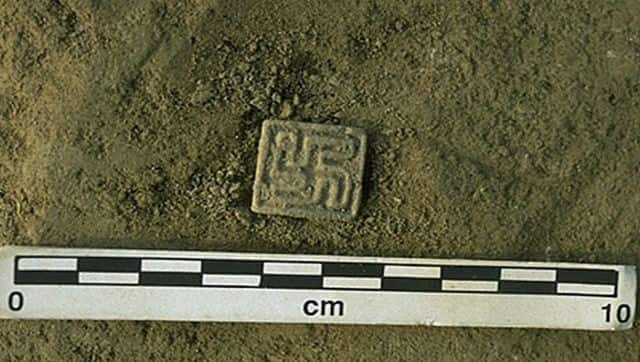 Seal found at Harappa depicting a swastika[/caption] Worship of mother goddesses In all ancient cultures, women were seen as the foundation pillars upon whom rested the important tasks of giving birth and rearing the young, and imbibing in them the prevalent social norms, culture-heritage, behavioural habits, and traditions. The women were seen as life producers with regenerative capacities, hence her organs that helped in procreation became the symbols of new life, and motherhood became the core figure in religious cults of those times. The paleolithic female figures found in abundance from various excavation sites show the popularity of Mother Goddess worship in prehistoric times; a religious practice that evolved with time and still remains popular in India as the worship of Shakti or the feminine principle. [caption id=“attachment_10168591” align=“alignnone” width=“640”]
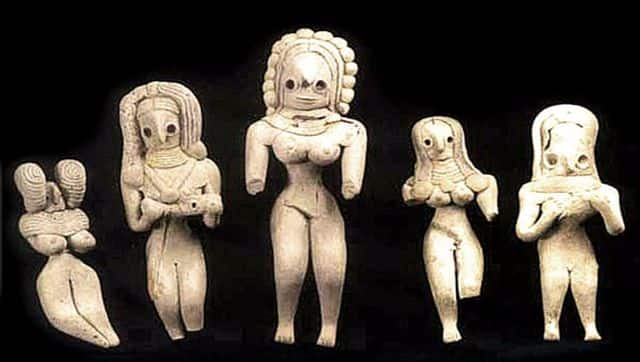 Mother goddesses from pre-Harappan era, Mehrgarh[/caption] Looking at Harappan times we come across various seals and artefacts, which according to the British archaeologist John Marshall belonged to the Mother Goddess cult, evident from the baetylic stones, ring stones, and phalli found in abundance from the various excavated sites. The Mother Goddesses discovered from India and modern Balochistan were typically represented as female figures with broad hips, narrow waists and heavy breasts to denote fertility and child bearing power. Besides the Mother Goddess figurines, a terracotta oblong seal was discovered from Harappa which shows a female figure (a deity) upside down, legs wide apart, a plant issuing from her womb, and arms in the same position as the Pashupati seal figure (vegetative fertility). This Harappan seal is easily comparable to the later terracotta reliefs from Bhita site of early Gupta period that show the Goddess in the same position with a lotus coming out from the neck instead of her womb (Lajjagauri or Aditi Utanapad). Devis in similar sitting position with legs wide apart have also been found from Bhita site and belong to the earlier Kushana era. These figures are symbolic of fertility and creation of new lives and carry with them the same concept of the Harappan Mother Goddesses. This association of the devi with vegetation matches the Shakamabhari concept found in Devi-Mahatmya of Markandeya Purana where the devi provides nourishment for all famine afflicted people from her own body. Here one interesting cultural aspect to note is that the Mohenjodaro Mother Goddesses mostly have a red slip or wash paint over them (including red colour in the hair parting). The red colour is associated with female fertility, and red ochre was often used by women (across all ancient cultures) to colour their bodies in order to improve their fertility. In India the cultural practice of using red colour is still seen among Hindu women who wear vermilion (sindoor) after marriage, signalling their bindings to one man and the readiness to procreate. [caption id=“attachment_10168601” align=“alignnone” width=“560”]
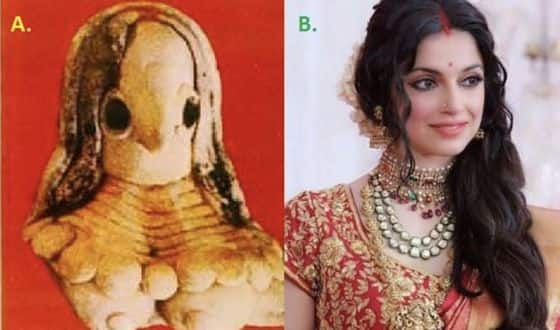 A: Figurine with red colour in hair parting from Nowshera (Balochistan 2700 BCE). B: Continuing tradition with the same underlying meaning of the colour red. Image from Google for representation purposes only.[/caption] Yoga mudras and other art forms From the famous Proto Shiva seal showing a figure sitting in Mulabandhasana to namaskara mudras and other yoga postures, all these postures continue till date and are an essential part of yoga practices. This is well explained in the given image. [caption id=“attachment_10168611” align=“alignnone” width=“640”]
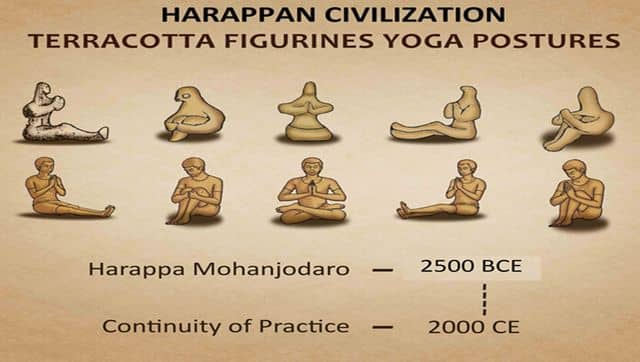 Image from Google[/caption]
![yoga1]()
[caption id=“attachment_10168631” align=“alignnone” width=“640”]
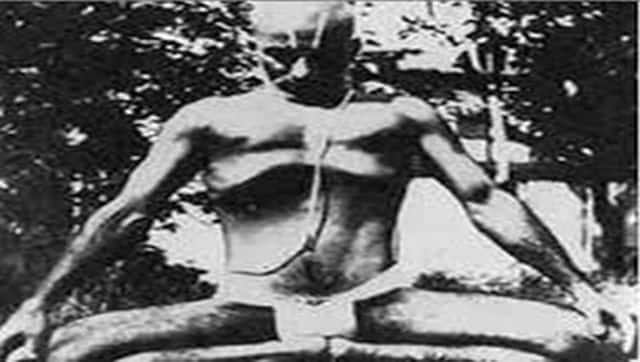 Mulabandhasana in a seal from Mohenjodaro (above), and Prof T Krishnamacharya sitting in the same asana in the 20th century. Images from Google for representational purposes only[/caption] Besides the continuity observed in Indian history from proto-historic to postmodern times in fabric prints, jewellery designs, tile patterns, and other motifs, a religious ornamental art known as Alponas also forms a part of the cultural heritage that shows historical continuity. These are ancient ritual arts known variously across India, such as alpona in West Bengal and Assam, aripana in Bihar, pakhamba in Manipur, jinnuti in Odisha, mandana in Rajasthan, sathia in Gujarat, sona rakhna in Uttar Pradesh, likhnu in Himachal Pradesh, etc. The word may have derived from the Sanskrit word ‘alimpan’ which means ‘to plaster’ or ‘to coat with’. It is also possible that the word alpona was derived from ‘ailpona’; the decoration art on ‘ails’ or embankments, believed to be magical, that kept villages and cities safe. The first traces of floor paintings were found in one of the Mohenjodaro seals, where the floor art as depicted on the seal was geometric in form, and looked like a mandala. The art still thrives today, and is seen across India in various forms during religious festivals. [caption id=“attachment_10168651” align=“alignnone” width=“640”]
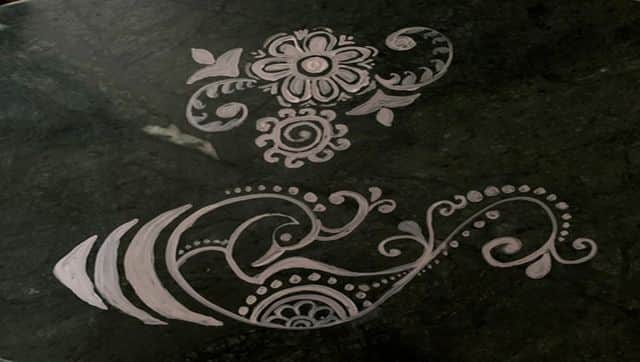 Alpona drawn during religious festivals in a Bengali household[/caption] A look at the terracotta toys and dolls made in rural parts of West Bengal and comparing them to the artefacts found from various Harappan sites also show a striking similarity, clearly standing as evidences of cultural continuity, as represented in the image below. [caption id=“attachment_10168661” align=“alignnone” width=“640”]
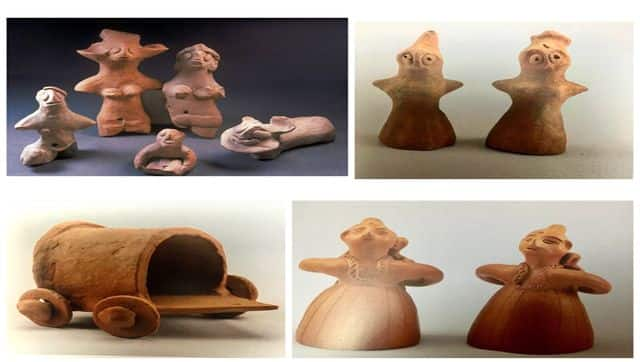 The top-left image shows artefacts from the Harappan sites, while the other three images are figurines and toys that are still made in rural parts of West Bengal[/caption] Thus, it is clear from the brief facts presented here that Indian culture and religion did not lack continuity. They evolved over time, often changing forms, but keeping the core meaning and values intact. While documentation or historical records may be sketchy at times, a closer look and analyses of the religious and cultural practices still prevalent in India will clearly show the continuing patterns that are seen on artefacts that were made at the start of Indian civilisation, and also in ancient scriptures and texts that mention these religious and cultural practices. The author is a well-known travel and heritage writer. Views expressed are personal. Read all the Latest News , Trending News ,
Cricket News , Bollywood News , India News and Entertainment News here. Follow us on
Facebook,
Twitter and
Instagram.


)

)
)
)
)
)
)
)
)



